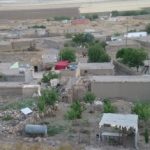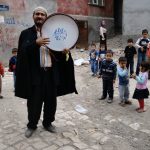Centre of all things Kurdish Population: 1,100,000
Old names: Amedros, Amed, Dikranagerd (Armenian)
Way over in the southeast of Turkey, Diyarabakır on the banks of the Dicle (Tigris) river is a city in three parts: the modern city; Sur, the walled city at the heart of it; and the squatter development of gecekondus beside that. For most visitors only the old city will be of interest. It’s a wonderful place, full of interesting old mosques, many of them built from striped black-and-white stone, and museum-houses enclosed behind 6kms of basalt walls dating back to Roman times (though largely rebuilt under the Byzantines). These walls and the Heyvel Gardens between them and the Dicle river are a designated UNESCO world heritage site. The many churches in the back streets testify to a city that was, before the First World War, truly multicultural.
Despite the myriad historic monuments, Diyarbakır’s history as the heart of the Kurdish resistance had militated against it developing a tourism industry on the same scale as Mardin. In the 2010s restoration of many old buildings suggested that things were about to change but then revived fighting, street blockades and sieges in 2015-16 put a stop to the progress. The trouble culminated with the demolition and rebuilding of the entire south-eastern quarter of the old city. Life is returning to normal again but it’s always wise to keep an eye on the political weather when planning a visit here.
Most of the accommodation is concentrated around Dağ Kapı (D. Kapı, pronounced “Dah Kaper”), the large tower that now stands detached from the walls beside the dreary square created when the old local bus station was turfed out of the town centre. It’s a great place to stay since you’ll be within walking distance of almost everything.
Don’t leave town without:
- Trying kaburga dolması (stuffed ribs) at Selim Amca’s – it’s more palatable than the other local favourite dinner item, ciğer (liver).
- Drinking meyankökü şerbeti, a liquorice drink sold by vendors on the street corners near the Nebi Cami
Around Sur (the old city)
[Getting Your Bearings] Sur is divided in two by Gazi Caddesi which runs north-south from the Dağ Kapısı to the Mardin Kapısı. Halfway down it is crossed by Melek Ahmet Caddesi to the west and Yenikapı Caddesi to the east which, between them provide a west-east road from the Urfa Kapısı to the Yeni Kapısı, thereby dividing the old city into quarters.
For many visitors the prominent Ulu Cami on Gazi Caddesi will be the first port of call. Screened from the main square by a wall with a deceptively low arched entrance cut through it, the mosque runs along one side of a spacious courtyard and immediately evokes the Ummayad Mosque in Damascus, albeit without the glittering mosaics.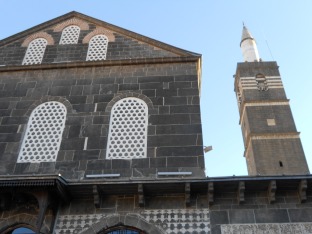 Built in 639 on the site of the ancient Mar Thoma church, the Ulu Cami is the oldest mosque in Anatolia, and you could pass several happy hours here simply inspecting the carved inscriptions on its facade, and the ancient columns and capitals reused in the surrounding buildings.
Built in 639 on the site of the ancient Mar Thoma church, the Ulu Cami is the oldest mosque in Anatolia, and you could pass several happy hours here simply inspecting the carved inscriptions on its facade, and the ancient columns and capitals reused in the surrounding buildings.
Despite having been restored several times over the centuries, the Ulu Cami has a timeless quality about it, which is hardly the case with the Hasan Paşa Hanı facing it across the road. This magnificent black-and-white stripy structure focused on a wide courtyard dates back to 1573 and a facelift has restored its joie de vivre. Cool music attracts a youthful crowd of students, and what were once the rooms in which trade goods would have been stored while their owners slept upstairs have been converted to house extremely popular blowout breakfast restaurants. You’ll have trouble dragging yourself away.
The han and the mosque are readily accessible from the main road running through Sur, but to get a better feel for old Diyarbakır you need to plunge into the medina-like back streets which harbour intriguing small museums, ancient churches, and lovely old mosques with extraordinarily beautiful striped minarets. The snag is that the streets are narrow and winding, rarely wide enough for a car to pass, and once you’ve got lost in them it won’t be easy to find your way back out again (the tourist office in the Dağ Kapısı (Mountain Gate) provides a helpful free map).
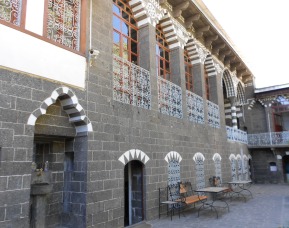 Cahit Sıtkı Tarancı MüzesiSeveral house-museums lie to the weat of Gazi Caddesi. Easiest to find is the Cahit Sıtkı Tarancı Müzesi which is very close to the Ulu Cami. Although the house was once home to one of Turkey’s finest romantic poets and exhibits a few of his belongings, you come here primarily to admire the exquisite local architecture in which flowers of white stone are incised into the heavy basalt walls to picturesque effect. The museum displays lots of interesting information about the local music and architecture but labeled only in Turkish.
Cahit Sıtkı Tarancı MüzesiSeveral house-museums lie to the weat of Gazi Caddesi. Easiest to find is the Cahit Sıtkı Tarancı Müzesi which is very close to the Ulu Cami. Although the house was once home to one of Turkey’s finest romantic poets and exhibits a few of his belongings, you come here primarily to admire the exquisite local architecture in which flowers of white stone are incised into the heavy basalt walls to picturesque effect. The museum displays lots of interesting information about the local music and architecture but labeled only in Turkish.
The house immediately next door is now open as a museum to the poet Ahmet Arif (1927-91) who was born in Diyarbakır.
The house in which the Turkish nationalist Ziya Gökalp was born in 1876 is similarly beautiful in design, if a little harder to find; it was damaged during protests in 2014 but has since been restored.
Several churches are grouped together east of Gazi Caddesi near the striking, detached Dört Ayaklı Minare (Four-Footed Minaret), in front of the much more conventional Şeyh Mutahhar Cami. If you send a postcard from the nearby post office you’ll find yourself queuing for a stamp inside a church that has been given a completely new use unlike the mainly 17th-century Mar Petyun Keldani Kilisesi (Chaldean Catholic Church) which is surprisingly large and still open for a handful of worshippers. Even bigger is the The more cosmopolitan past 19th-century Armenian Surp Giragos Kilisesi which has five apses and a striking belltower. After undergoing a high-profile $2,600,000 restoration, it was wrecked in the troubles of 2015-16 and only reopened again in 2022. The bookshop housed on the ground floor of the priest’s house which forms part of the complex used to display interesting information about the days before 1915. I don’t know if it still does.
The more cosmopolitan past 19th-century Armenian Surp Giragos Kilisesi which has five apses and a striking belltower. After undergoing a high-profile $2,600,000 restoration, it was wrecked in the troubles of 2015-16 and only reopened again in 2022. The bookshop housed on the ground floor of the priest’s house which forms part of the complex used to display interesting information about the days before 1915. I don’t know if it still does.
The Esma Ocak Evi (bang on the door for admission) stands apart from the other house-museums immediately opposite Surp Giragos.
Further south towards the Mardin Kapısi the stripy Delliler Hanı (Guides’ Han) has been converted into the Otel Büyük Kervansaray. Nearby is a cheese market that is a mouth-watering feast for the eyes.
Out on a limb to the east of Gazi Caddesi is Meryemana Kilisesi (Church of the Virgin Mary), probably dating back to the 6th century, which is still used by Diyarbakır’s tiny Syrian Orthodox community.
Around the walls
No one could visit Diyarbakır and overlook the extraordinary walls with which it’s ringed. Built from basalt, these date back to the days of the Roman occupation, although every successive ruler of the city appears to have felt the need to stamp his mark on them by adding a tower or tweaking a stretch of wall. Some adjacent areas have been spruced up to appeal to visitors with the addition of landscaping and children‘s play areas.
In theory you can walk right round the walls, certainly at the bottom and in some places along the top of the ramparts too. In reality, however, gecekondus (shanty towns) still cling to parts of them and you will probably feel very conspicuous, not to say uncomfortable, venturing into these on your own. Unfortunately this means that two of the most photographed towers — the Yedi Kardeş Burcu (Seven Brothers Tower) and Malikşah Burcu (Shah Malik Tower) – – remain largely off-limits for the time being.
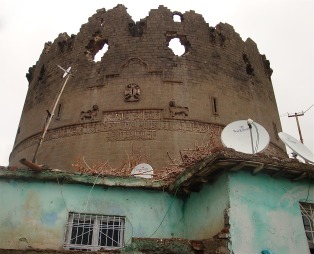 In the northeast corner of the walls what used to be the closed military zone of the İç Kale (Inner Citadel) has been converted a peaceful and evocative place despite its grisly recent history. It’s accessed by passing under a high arch dating back to 1206-7 when the Artukids held sway over everywhere from here to Mardin. Inside the İç Kale now houses a fine Archaeological Museum (closed Mondays) with the finds from many rescue digs carried out before sites were drowned by dams. It also houses the Kent Müzesi (City Museum) although this has no English labelling making it hard for visitors to appreciate.
In the northeast corner of the walls what used to be the closed military zone of the İç Kale (Inner Citadel) has been converted a peaceful and evocative place despite its grisly recent history. It’s accessed by passing under a high arch dating back to 1206-7 when the Artukids held sway over everywhere from here to Mardin. Inside the İç Kale now houses a fine Archaeological Museum (closed Mondays) with the finds from many rescue digs carried out before sites were drowned by dams. It also houses the Kent Müzesi (City Museum) although this has no English labelling making it hard for visitors to appreciate.
Also here are the remains of an old prison and of the very impressive Church of St George. This may date back to the third century and has survived as well as it has because it was later turned into a hamam. Its striking white pillars and elliptical dome have no parallels elsewhere in Turkey.
Right beside the İç Kale is the 12th-century Hazreti Süleyman Camii where several early Islamic heroes are buried, attracting crowds of worshippers no matter what the time of day.
Beyond Sur
On the road south from the Mardin Kapısi to the river the glorious Gazi Köşkü is a stripy stone summer house dating back to the 15th century and sitting in fields overlooking the Dicle river (Tigris). It may or may not still be housing offering a popular restaurant and tea garden.
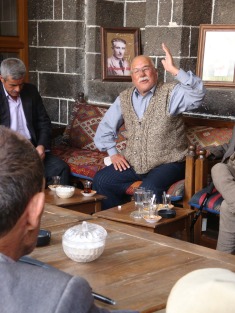
Entertainment
While in Sur, don’t miss the Dengbej Evi, a wonderful venture housed in one of the better-signposted of the old houses in the back streets. Dengbej is a style of unaccompanied music in which the great sagas of Kurdish history are recorded. Sitting in the enclosed courtyard, admiring the exquisite stone architecture and listening to the old men relaying their songs back and forth, it’s hard to remember the darker Diyarbakır of not so long ago.
Eating and drinking
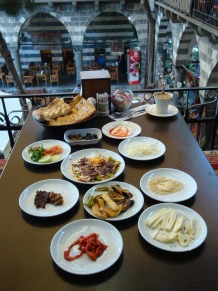 One of the most popular things to have for dinner in Diyarbakır is grilled ciğer (liver) which can be sampled at any number of places, formal and informal, around Dağ Kapı. Personally, I prefer the more casual liver-eating scene in Urfa.
One of the most popular things to have for dinner in Diyarbakır is grilled ciğer (liver) which can be sampled at any number of places, formal and informal, around Dağ Kapı. Personally, I prefer the more casual liver-eating scene in Urfa.
Another local favourite dish is kaburgaı dolması (stuffed lamb ribs shredded onto rice), best sampled at the Selim Amca restaurant within easy walking distance of Kıbrıs Caddesi. Go in a group of at least two or three to be able to take advantage of this delicacy.
While it’s Van that is best known for its breakfasts, those on offer in the Hasanpaşa Hanı are veritable banquets well worth foregoing one so-so hotel breakfast to experience. Prices at the Hasanpaşa are a little on the high side. To join in the atmospheric han experience while spending a little less money look for the signposted but less obvious Sülüklü (Leech) Hanı, so named because at one time leeches used for medical purposes were stored here.
Two more lovely new breakfast venues opened in restored houses in the old city in 2014. The Zinciriye Konağı is behind the Ulu Cami, the Diyarbakırevi near the Chaldean church.
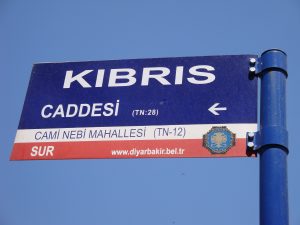 Sleeping
Sleeping
Although there are a few hotels right inside the old city, the best choice of places to stay in all budgets can be found in and around Kıbrıs Caddesi, near the Dağ Kapı (Mountain Gate) in the walls.
Compared with the hotels on offer in Mardin, Urfa, Elazığ and even Tunceli, many of Diyarbakır’s seem stuck in a time warp with toilet bowls that are not properly secured to the ground, centrally controlled heating and dodgy furnishings. The market is wide open for a truly boutique hotel. Needless to say, prices don’t always reflect the shortcomings of the amenities.
Class Hotel. In Sur and worth a look, not least because behind the mundane exterior it incorporates a lovely old Diyarbakır house. Tel: 0412-229 5000
Dedeman Hotel. If you prefer to stay in chain hotels this Dedeman is more centrally located than most and within walking distance of Dağ Kapı. Tel: 0412-229 0000.
Liluz Hotel. Glitzy newcome inside the walls near the Nebi Cami. Charging in euros which is hardly a good development. Tel: 0412-224 3434
Miroğlu Hotel. Just down the round from the Turistik Hotel. Tel: 0412-229 6000
Transport info
Diyarbakır airport (DIY) is west of the town centre and offers regular flights from İstanbul and Ankara. You can get there by bus from Kıbrıs Caddesi.
City buses and dolmuşes pass the fine new bus terminal and will drop you at Dağ Kapı near most of the hotels.
The separate İlçe Otogar/Garajı serves the towns and villages in the immediate vicinity such as Eğil, Silvan, Siverek (for Urfa) and Mardin. To get to the İlçe Garajı take a dolmuş from Kıbrıs Caddesi.
Diyarbakır’s growing prosperity has spawned far too many cars and getting out of the city can take much longer than you might expect. Don’t leave things to the last moment.
Day trip destinations
Read more about the İç Kale and my relationship with Diyarbakır: http://www.turkeyfromtheinside.com/index.php?option=com_easyblog&view=entry&id=46&Itemid=218
Read about the dengbej tradition in The Guardian: http://www.guardian.co.uk/world/2011/dec/28/kurdish-singing-storytellers-rise-dengbej?INTCMP=SRCH
See images of Diyarbakır’s many stripy mosques: https://www.facebook.com/media/set/?set=a.301287956705110.1073741868.137912259709348&type=1
Read more about the redevelopment of Sur: https://bianet.org/yazi/sur-in-name-only-how-post-conflict-reconstruction-is-changing-diyarbakir-268622
Read more: The Trouble With Tourism
 Sülüklü Han cat
Sülüklü Han cat

